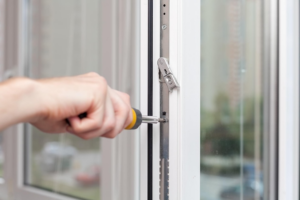20 Myths About Lock Replacement: Debunked
페이지 정보

본문
 Door Lock Replacement - What Are the Different Parts of a Door Lock?
Door Lock Replacement - What Are the Different Parts of a Door Lock?A broken door lock can make your house an easy to target for burglars. Changing your lock is a cheap option to improve security without making your door inaccessible.
Many locks come packaged with a cardboard template that you can use to wrap around the edge of your door to make sure it fits properly. This will help you avoid purchasing the wrong lock.
The Cylinder
The cylinder, also referred to as the body of the lock, is the primary component of a traditional mechanical door lock. It has a number of spring-loaded pins that keep the door closed in the event that no key is inserted in the hole. When keys are placed into the doorknob the uneven edge presses upwards on the pins inside of the cylinder, fitting them to their correct positions. When the pins fit they allow the bolt, also referred to as the latch, to move forward and engage the inside of your door.
The bolt extends from the cylinder into an opening in your door frame that is called the box. The box is designed to fit the bolt tightly, so that it can't be easily opened. A clip spring ensures that the bolt is retracted when the door is closed. When you turn the handle and the spindle inside the cylinder rotates. When it's done rotating the slanted portion of the bolt is retracted into the doorframe. The bolt rests on the carved-out area of the doorframe and closes the door until you are required to reopen it.
A faceplate is a metallic plate that attaches to the interior of your door, either side of the deadbolt hole. Its function is to protect the mechanism that locks your door from damage caused by the knob's repeated insertion and removal. If you're installing a new lock, ensure that the faceplate is aligned with the hole in your door frame and is securely fastened to the faceplate and the bore of your latch.
When replacing the lock on a door make sure that the deadbolt is correctly seated by sliding it into the opening of the strike plate. Once you're done, screw the strikeplate and key of the lock into the hole. Do not over-tighten as this could damage the latch or hinder it from fitting into its groove. You can test your new lock by rotating the key with the lock in the locked position. If you notice any problems like a loud deadbolt or a loose latch it's recommended to replace the old lock with a brand-new one.
The Faceplate
A faceplate is a flat plate that attaches to the headstock of a lathe in order to hold the workpiece. It has a variety of screw holes that are drilled through it, where the screw thread enters from the back and winds into the wood. Faceplates can accommodate many different shapes, but in general they have to be positioned properly, balanced and fixed that aren't simple tasks when compared to the ease of using an chuck.
A typical faceplate is fitted with a number mounting holes. In this instance, three are positioned at 120 degrees intervals to accept the screws for mounting in FIGURE. 2. The screw holes are made using an interchangeable insert 16 or directly into the faceplate's body. The faceplate features an area of stepped in the middle which acts as an index mark for locating a specific location on the blank workpiece.
The stepping area is resistant to abrasion so that the fastener won't harm the chisel used to cut it. The surface of the faceplate body has different properties than the surrounding region. Machining into this area warns the operator of coming contact with fasteners, and gives them time to react.
Screws used to secure a faceplate should have a little free play in the screw hole. When the screw is tightened onto the glue block, there should be no space behind it. This may permit the block during rotation to shift. It is also an ideal idea to use a heavier gauge screw because it will be more secure in the faceplate. The screw should pass through the middle of the screw hole to prevent the possibility of a screw head getting into contact with the workpiece.
The Strike Plate
The strike plate is one of the most important parts of your door lock. The strike plate is what stops the bolt from sliding when you shut the front door. The strike plate can also help reinforce the window lock repairs near me and prevents intruders from breaking in by applying force against the latch and jamb.
A strike plate is an thick metal plate installed in the doorjamb or the vertical portion of the frame. It has a hole through which the latch or deadbolt can pass. When the cylinder rotates it shoots the bolt through the strike plate into the doorjamb, securing it closed.
There are many different kinds of strike plates based on your needs. If you require a strike plate to fit with your specific lock, it will be listed in the details of the product. In other cases, most strike plates are the same and can be used with the majority of standard latches and locks.
The majority of standard strike plates have ovular screw holes and an "C-shaped" piece that acts as washer. They are commonly used on doors that have corner rounded edges. They are available in various sizes to match the door.
You can enhance security by using a strike plate with no lip, which is designed for deadbolts. This is a great option for areas where security has to be accomplished quickly, such as stairs. It's also a great choice to secure items or documents within your home.
Another way to upgrade the security of your door is by installing a box strike plate, which adds thickness and reinforcement to the strike plate. This makes it much harder to gain entry through the deadbolt or latch. It is usually required on commercial doors with a security lock.
If your strike plate isn't aligned with the latch bolt Try spraying it with a quality lock lubricant. If this doesn't work, you will have to modify the strikeplate by drilling new screwholes and widening your catch hole. Be cautious not to make many adjustments to the strike plate, since repeated and extreme changes can weaken it to the point where it's no longer effective.
The Deadbolt
A deadbolt is an iron bolt that connects the door to the doorjamb frame. As opposed to a spring-latch that is used in doorknobs which can be tied (jimmied) using credit cards or professional tools like latch slips, a deadbolt is locked using keys, thumb turns or electronic (in the case of smart and keyless deadbolts). They provide better protection against forced entry techniques like kick-ins and are easy to use with minimal maintenance.
The bolt extends through a socket or hole in the doorjamb that is strengthened by a strike plate for additional security. The bolt must be at least 1 inch long to make it more difficult to pull off the door. It is also recommended to select deadbolts with an ANSI rating, which indicates how secure the lock is.
The strike plate also keeps the cylinder in place. Three holes should run across the bolt. One of them connects the facepiece to the cylinder, and the other two are on either side of the central hole. The screws are inserted in these holes to connect the cylinder and bolt. The screws should be part of the new deadbolt. Some locks have decorative covers which attach to the facepieces. Consult the instructions provided by the manufacturer to ensure that they are installed correctly.
Choosing the right lock for your home requires considering your lifestyle and what security level you need. Single cylinder deadbolts are the most popular type of window lock repairs can be found on a variety of exterior door. Keyless deadbolts can be more secure, but they are more difficult to use. Smart deadbolts let you lock and unlock the bolt with voice commands or an mobile app.
A professional locksmith can assist you to decide which type of lock is best for your home, and install or replace it. Upgrade your front door upvc window lock repair cost system to increase the security of your home. To provide additional security, you could think about adding a reversible double glazed window lock mechanism replacement-cylinder deadbolt to the outside of your door, too.

- 이전글뉴토끼 소설 ※주소모음※ 19링크모음 뉴토끼 주소모음 24.11.22
- 다음글Diyarbakır Escort Liseli Kızlar 24.11.22
댓글목록
등록된 댓글이 없습니다.
